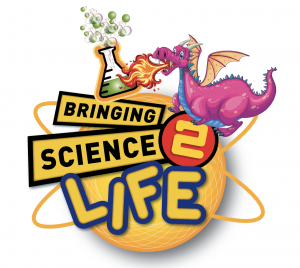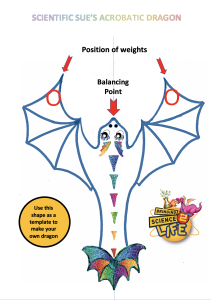Build your own Acrobatic Dragon
🐉 Scientific Sue’s Acrobatic Dragon
Defy Gravity, Discover Science, and Delight in Dragons!
Looking for a simple yet magical hands-on science activity that ties in beautifully with physics in the classroom—or sparks curiosity at home? Then let us introduce you to Scientific Sue’s Acrobatic Dragon: a gravity-defying creature that performs the ultimate balancing act—on the tip of its nose!
With just a few household materials and a dash of imagination, children can build their very own acrobatic dragon—and learn all about the centre of mass, balance, and gravity while they play.
🎯 Aim of the Activity
Create a majestic cardboard dragon that can balance on its nose like a circus performer on a tightrope! With a little science and clever design, you’ll wow your friends and family while exploring some serious physics fundamentals.
🛠️ What You’ll Need
-
Thin card (recycled cereal boxes work great!)
-
Scissors
-
Glue or sellotape
-
Colouring pens or pencils
-
Small weights: paperclips, playdough blobs, or coins
🔍 Secrets for Success
-
Download and Print the template. You can print it directly onto thin card, or print on paper and glue it to recycled card (hello, breakfast boxes!).
-
Cut and Colour your dragon to bring it to life—make it fierce, funny, or full of flair.
-
Test the Balance. Try to balance it on your fingertip. Spoiler alert: it probably won’t stay up—yet!
-
Shift the Balance. To make your dragon balance on its nose, you’ll need to adjust where its centre of mass is. Add weights to the front tips of the wings until it balances.
-
Experiment! Try different weights, card thicknesses, or even scaling the dragon up or down. What happens to the balance point?
🧪 Science in a Nutshell: The Physics of Balance
Every object has something called a centre of gravity (also known as the centre of mass)—it’s the point where the weight is evenly balanced in all directions. Think of it as the “sweet spot” that keeps things upright.
-
When the centre of mass is high, an object is more likely to topple over.
-
When it’s low and directly above a base, the object becomes more stable.
The wings of your dragon have been strategically designed to extend and hold extra weight in front of the body. This clever engineering shifts the centre of gravity forward—right to the nose—making your dragon balance like a seasoned acrobat!
And here’s where the real learning kicks in:
-
Try changing the shape or size of the dragon—what happens to its balance?
-
What if you move the weights closer or farther from the nose?
-
How does the type of card you use change the effect?
This hands-on activity gives children the opportunity to investigate forces, balance, and stability—key topics in the primary science curriculum. It’s perfect for introducing terms like gravity, mass, and equilibrium in a fun, practical way.
📚 Curriculum Connections
This project supports learning outcomes in:
KS1 & KS2 Science – Forces & motion, gravity, stability, design and testing
Forces & Motion
-
Pushes and pulls
-
How objects move on different surfaces
-
Magnets (attraction and repulsion)
-
Gravity (introduction)
-
Friction, air resistance, and water resistance (upper primary)
Materials
-
Properties of everyday materials
-
Suitability of materials for a purpose
-
Reversible and irreversible changes (linked to glueing, cutting, etc.)
Working Scientifically
-
Asking questions
-
Making predictions
-
Planning investigations
-
Observing and measuring
-
Recording results
-
Drawing conclusions and identifying patterns
Everyday Physics Concepts
-
Balance and stability
-
Simple machines (levers, pulleys, etc.)
-
Light and shadows (not directly relevant here, but often tied into broader physical science themes)
Secondary Science Topics (KS3 / Ages 11–14)
Physics: Forces
-
Types of forces (gravity, friction, contact/non-contact)
-
Force diagrams
-
Resultant force and equilibrium
-
Centre of mass and stability
-
Turning forces (moments, levers, torque)
Physics: Motion and Energy
-
Balanced vs unbalanced forces
-
Speed and acceleration
-
Energy transfers in physical systems (e.g. potential energy when lifting mass)
Scientific Enquiry Skills
-
Experimental design
-
Variables: independent, dependent, controlled
-
Data collection and analysis
-
Evaluating results and making improvements
Cross-Curricular Links
-
Design & Technology (DT): Making structures stable, product design, prototyping
-
Maths: Measuring, averaging, estimating, using scales
🎯 How Your Acrobatic Dragon Links to Curriculum
| Concept | Curriculum Link |
|---|---|
| Centre of mass | KS2 Forces; KS3 Stability and moments |
| Gravity & balance | KS1–KS3 Forces and motion |
| Investigating how weight affects balance | Working scientifically (KS1–KS3) |
| Trial and error to find balance point | Scientific enquiry & problem-solving |
| Designing and testing models | Design & Technology and Physics |
Whether used in the classroom, after-school clubs, home education, or weekend crafting, Scientific Sue’s Acrobatic Dragon combines artistic fun with scientific learning—perfectly balanced, just like the dragon!
🎉 Ready to Try It?
Head over to my online store to download your Acrobatic Dragon Template, grab your scissors and cereal boxes, and get ready to wow your audience with a magical mix of physics and fun!
Let the balancing act begin!


